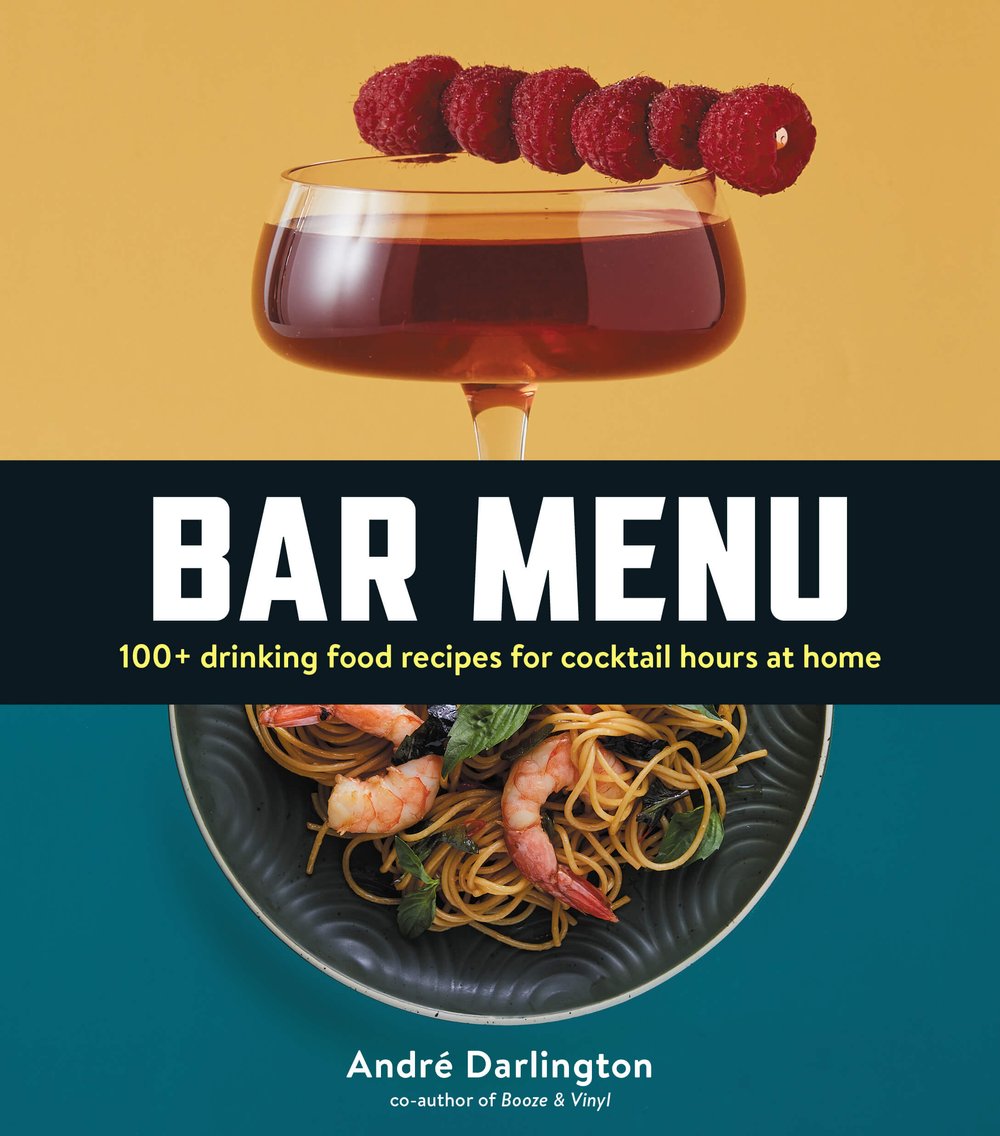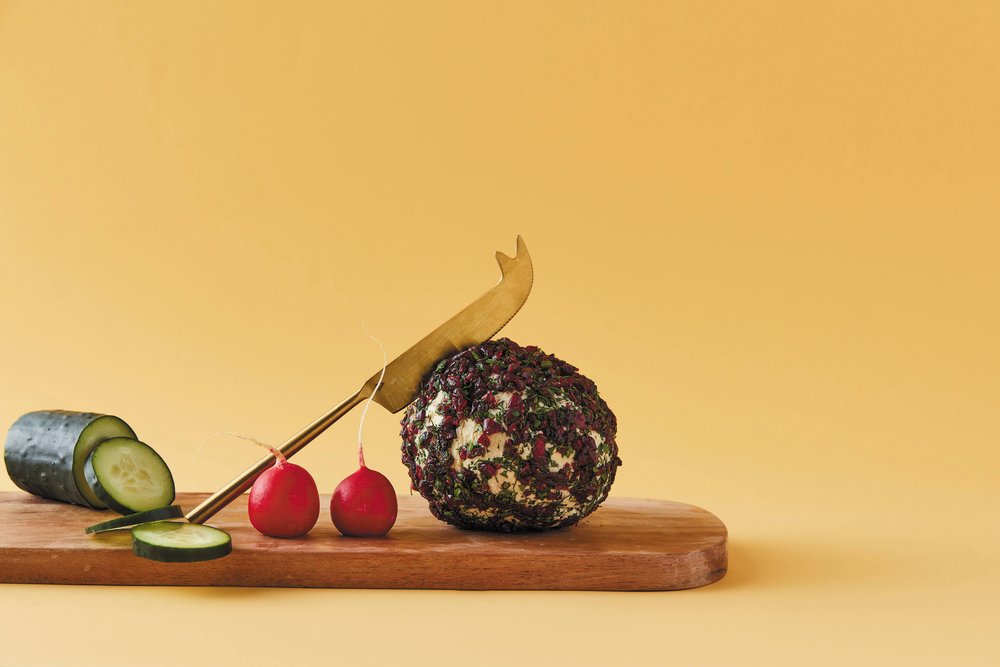André Darlington photo credit Andre Rucker
André Darlington is the author of half a dozen books on food and drink (including a few co-written with his caseophile sister Tenaya, AKA Madame Fromage). His latest, Bar Menu: 100+ Drinking Food Recipes for Cocktail Hours at Home, collects simple yet inventive recipes designed to make the food at your next sipping session as good as the carefully crafted drinks—including an entire section of delicious and surprising cheese-centric recipes. Darlington shared his tips for cheese lovers looking to experiment with cocktails alongside their wheels and wedges.
Start in your comfort zone
Not sure where to begin pairing cocktails and cheese? Darlington recommends starting with recipes that incorporate familiar, fizzy champagne as a way into the world of mixed drinks. “There’s no harm in hanging your hat on what you already know about wine pairing,” he says.
Champagne cocktails like a French 75—bubbly, citrusy, and made with a bold, herbaceous gin like St. George’s Botanivore—are natural pairings for cheeses like fresh chévre as well as Camembert and other soft-ripened wheels. “What makes a cocktail great for food is that it’s cutting those fats or responding to salt or sweets in the food,” he says.
Go beyond European styles

Darlington wrote Bar Menu during the pandemic, but he had ample inspiration to work with: Prior to 2020, he circumnavigated the globe in preparation for Booze Cruise: A Tour of the World’s Essential Mixed Drinks, and his experiences in parts of the world that are often overlooked in the cheese world inform several the book’s most exciting recipes.
“I saw all these cultures taking on the cocktail and then finding what worked in their culture—the stuff that’s high acid, high flavor, high umami, crunchy, salty—as bar snacks,” he says.
Shepherd’s Bulz, Fontina-stuffed polenta balls baked in the oven, are adapted from an Albanian tradition. In Turkey, sky cheese gets its name from the blue and green molds that grow on fresh sheep’s milk cheese wrapped in animal hide and buried in the ground; after it’s dug up, the cheese is baked with honey, onions, and walnuts. (Darlington suggests pungent Roquefort as a stateside substitute, but any blue will work.)
Even his Cheese Ball, Reimagined, takes inspiration outside of the American or European cheese mainstream. It’s inspired by doomayj, a salad-like snack of crisp lavash bread, crumbled feta, nuts, and herbs. Darlington’s cheese ball blends blue and mascarpone with fresh basil, chives, and dill with the requisite nuts and dried fruit for crunch.
When in doubt, follow flavor bridges
It’s easy to fall back on the idea that pairing food and beverage is like a math problem with only one right answer, but the reality is much more flexible. Unlike wine or beer, cocktails are made up of at least a few—and often several—ingredients that offer different flavors, textures, and aromas. These components can serve as the pivot point between a cheese and a cocktail you may not have thought to try together.
“I’ve found that martinis go with everything, but that’s because they’re kind of blank,” Darlington says. Rather than sticking with neutral cocktails like martinis or gin and tonics, he suggests starting with a drink that has more character and looking for affinities between its ingredients and different wheels.
“If you’re putting an Amarena cherry in a Manhattan, it’s going to go with so many cheeses,” he says. “It’s like a liquid cheese board. You’ve got your fruit in your drink instead of on the board.”
Explore Alpines or even salty blues to complement the fruity, caramel notes of a Manhattan. A puckery gimlet, Darlington suggests, will match well with a cheese style that goes well with citrus, such as a fresh or soft-ripened goat cheese. Read more about cheese and drink “bridges.”
Consider preparing cheese as an appetizer rather than serving it unadorned

High-quality cheese can certainly hold its own alongside a mixed drink, but Bar Menu makes a strong case for recipes to make the most of your next cocktail hour. Enhancing cheese by cooking, blending with herbs and spices, or adding crisp, crunchy textural elements is a smart move with cocktails, Darlington says, because the original Prohibition-era bar snacks—pickled eggs, salted or flavored nuts, cheese balls— tended to be rich, crunchy, and/or salt-forward.
The quick, simple recipes in Bar Menu use heat, spices, syrups, and textural elements like nuts and dried fruit to amp up cheeses for the cocktail experience, with ingredients often drawn from the kinds of familiar pairings you’d see on a cheese board. Darlington’s Frico Manchego recipe transforms the Spanish icon into crispy, walnut-studded bites that complement drinks like Manhattans and Old Fashioneds (Darlington recommends a bourbon like Michter’s US 1, whose honey and peach notes can bring out subtle flavors in long-aged wheels). Smoky liptauer, a Central European cheese spread he first tried in Austria, melds tangy cream cheese with spices like paprika and caraway that play well with flavor notes in a wide range of cocktails.
“You can put out Manchego and walnuts, but let’s stick it in the oven and make it crispy,” Darlington says. “There’s a little bit of process in there.”
Quick, simple preparations like these also provide the opportunity to incorporate additional ingredients that can bridge between cheeses and cocktails. Darlington’s Sweet and Sour Burrata recipe incorporates Amarena cherries, while his Fried Halloumi with Carob Syrup goes so well with brandy drinks like the citrusy Cypriot Brandy Sour because of those caramelized, chocolatey notes in the syrup.
“I always tell cheese people to not be fearful of being adventurous,” Darlington says. Though craft cocktails are commonplace in restaurants and bars these days, they still lag behind wine and even beer in the cheese world, so there’s still lots for caseophiles to discover as they explore the world of mixed drinks.
“I think it took cocktails becoming cheffy, and people realizing that cocktails themselves can be a work of art, and they can be delicate and really high quality, for people to realize, ‘We can pair this stuff,’” he says.
The Cheese Ball, Reimagined
SERVES 4 TO 6
Although the cheese ball has entered the realm of American kitsch foods, it has an important history as a Prohibition staple. The molded balls covered in nuts were often served in speakeasies and, as such, they are part of the cocktail food canon. Wanting to salvage this historic cocktail pairing from nervous laughter at my parties—while everyone loves a cheese ball, few will admit it—I looked for inspiration in the city of Tabriz in Iran, a former Spice Route stop. There, I found a dish called dooymaj, which includes feta, walnuts, fresh herbs, butter, and lavash bread. I spun this into an Americana version of a cheeseball . . . and the result is a thing of beauty.
8 ounces mascarpone
4 ounces blue cheese, crumbled
1⁄4 cup chopped pecans
1 tablespoon finely sliced scallion
2 teaspoons hot sauce, such as Tabasco
2 teaspoons Worcestershire sauce
1⁄4 teaspoon salt
1⁄4 teaspoon freshly ground black pepper
1⁄4 cup chopped dried cranberries
1 tablespoon finely chopped fresh basil
1 tablespoon finely chopped fresh chives
1 tablespoon finely chopped fresh dill in a large bowl, combine mascarpone, blue cheese, pecans, scallion, hot sauce, Worcestershire sauce, salt, pepper, and
1⁄8 cup of the cranberries.
Form the mixture into a ball and refrigerate, covered, for 30 minutes. Mix together remaining 1⁄8 cup of cranberries, basil, chives, and dill on a large plate and roll the cheese ball around to cover all sides. Serve with The Cracker (page 167) and cut veggies.
Recipe from BAR MENU: 100+ Drinking Food Recipes for Cocktail Hours at Home by André Darlington. Copyright © 2022. Available from Running Press, an imprint of Hachette Book Group, Inc.
